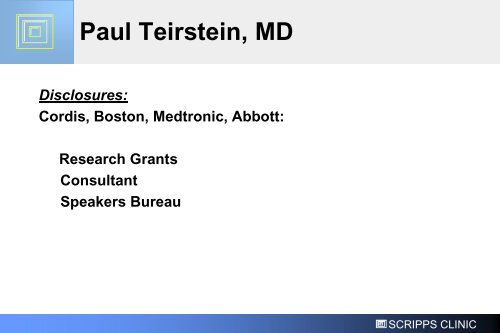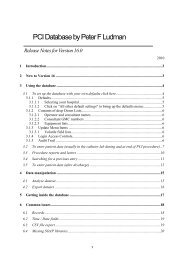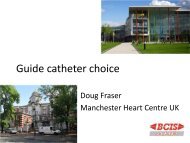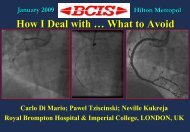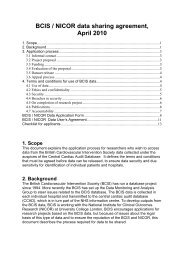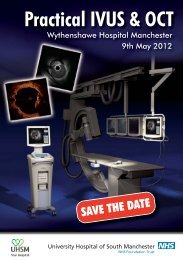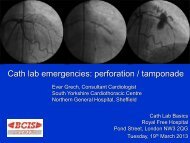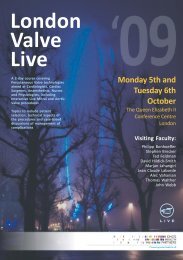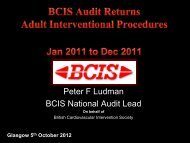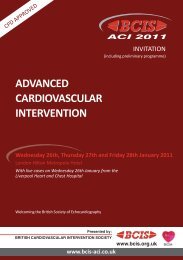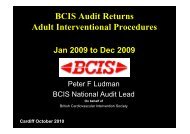Paul Teirstein MD
Ah- the benefit of hindsight - British Cardiovascular Intervention ...
Ah- the benefit of hindsight - British Cardiovascular Intervention ...
- No tags were found...
Create successful ePaper yourself
Turn your PDF publications into a flip-book with our unique Google optimized e-Paper software.
<strong>Paul</strong> <strong>Teirstein</strong>, <strong>MD</strong><br />
Disclosures:<br />
Cordis, Boston, Medtronic, Abbott:<br />
Research Grants<br />
Consultant<br />
Speakers Bureau<br />
SCRIPPS CLINIC
Ahh….the benefit of hindsight<br />
<strong>Paul</strong> <strong>Teirstein</strong>, <strong>MD</strong><br />
Chief of Cardiology<br />
Director of Interventional Cardiology<br />
Scripps Clinic<br />
La Jolla, California<br />
SCRIPPS CLINIC
A Bold New Era In Cardiovascular<br />
Disease<br />
We need bold new lectures.<br />
•Lectures that go deeper, ie “Ahh….the<br />
benefit of hindsight”<br />
•Modern speakers now stress EMOTION<br />
over CONTENT<br />
•They tell us how they feel, not what they<br />
think!<br />
SCRIPPS CLINIC
“Ahh….the benefit of hindsight”<br />
Ideas for future lectures:<br />
• Phew….that data smells awfully fishy to me<br />
• Expletive deleted! My hospital administrators are killing<br />
me<br />
• Blah…another one of my papers got rejected<br />
• Wow!...that was a great case<br />
• Yuck!.....got burned by another stent thrombosis<br />
• Ahhh….the benefit of foresight<br />
• Since foresight only becomes apparent in hindsight,<br />
you cant have foresight without hindsight.<br />
SCRIPPS CLINIC
“The farther backward you can look, the farther forward you are<br />
likely to see."<br />
---Winston Churchill<br />
SCRIPPS CLINIC
“Ahh….the benefit of<br />
hindsight”<br />
“Benefit of hindsight” is really a<br />
chance to talk about mistakes<br />
Mistakes:<br />
• Inadequate response to the COURAGE trial<br />
• Our erroneous referral of too many patients to bypass<br />
surgery<br />
• Mistakes I have made in the cath lab<br />
• Mistakes I have made in my career and my life<br />
SCRIPPS CLINIC
Mistake #1<br />
COURAGE trial results<br />
should have been more<br />
forcefully refuted<br />
SCRIPPS CLINIC
Homicide: n. The killing of one person by another<br />
• Criminal Homicide:<br />
• Murder first degree: Premeditation, intent<br />
• Murder Second degree: intent, no premeditation<br />
• Manslaughter 1 st degree (voluntary manslaughter):<br />
• Intent, heat of passion, a reasonable person is provoked to kill<br />
• Manslaughter 2 nd degree (involuntary manslaughter or negligent homicide):<br />
• No intent, but did not act with the care and caution of a reasonable<br />
person (ie kicking brick off bridge that hits someone below)<br />
• Reckless homicide – aware of risk but does not care, ie driving<br />
recklessly at 90 MPH<br />
• Non-Criminal homicide<br />
• Justifiable homicide – kill to protect yourself, police officer killing in the<br />
line of duty,<br />
• Accidental homicide: A lawful act done under a reasonable belief that no<br />
harm is possible
Harmonizing Outcomes with Revascularization and Stents in AMI<br />
≥3400* pts with STEMI with symptom onset ≤12 hours<br />
Aspirin, thienopyridine<br />
UFH + GP IIb/IIIa inhibitor<br />
(abciximab or eptifibatide)<br />
R<br />
1:1<br />
Bivalirudin monotherapy<br />
(± provisional GP IIb/IIIa)<br />
Emergent angiography, followed by triage to…<br />
CABG –<br />
Primary PCI<br />
–<br />
Medical Rx<br />
3000 pts eligible for stent randomization<br />
R<br />
1:3<br />
Bare metal stent<br />
TAXUS paclitaxel-eluting stent<br />
*To rand 3000 stent pts<br />
Clinical FU at 30 days, 6 months,<br />
1 year, and then yearly through 5 years
Mortality (%)<br />
1-Year Mortality: Cardiac and Non Cardiac<br />
Excess deaths 3 =<br />
2.9%<br />
30<br />
Number at risk<br />
Bivalirudin alone<br />
Heparin+GPIIb/IIIa<br />
5<br />
Mortality =<br />
4<br />
68 vs 38 pts<br />
2<br />
1<br />
0<br />
Bivalirudin alone (n=1800)<br />
Heparin + GPIIb/IIIa (n=1802)<br />
1.8%<br />
Time in Months<br />
HR [95%CI] =<br />
0.57 [0.38, 0.84]<br />
P=0.005<br />
Cardiac<br />
Δ = 1.1%<br />
P=0.03<br />
Non Cardiac<br />
1.3%<br />
1.1%<br />
0 1 2 3 4 5 6 7 8 9 10 11 12<br />
1800 1705 1684 1669 1520<br />
1802 1678 1663 1646 1486<br />
3.8%<br />
Δ = 1.7%<br />
2.1%
Homicide: n. The killing of one person by another<br />
• Criminal Homicide:<br />
• Murder first degree: Premeditation, intent<br />
• Murder Second degree: intent, no premeditation<br />
• Manslaughter 1 st degree (voluntary manslaughter):<br />
• Intent, heat of passion, ie provoked to kill<br />
• Manslaughter 2 nd degree (involuntary manslaughter or negligent<br />
homicide):<br />
• No intent, but did not act with the care and caution of a reasonable<br />
person (ie kick brick off bridge)<br />
• Reckless homicide – aware of risk but doesn‟t care,ie driving<br />
recklessly at 90 MPH<br />
• Non-Criminal homicide<br />
• Justifiable homicide – kill to protect yourself, police officer killing<br />
in the line of duty,<br />
• Accidental homicide: A lawful act done under a reasonable belief<br />
that no harm is possible
Hypothetical trial<br />
The HOLIE CHUTE trial<br />
Group A<br />
Group B<br />
Primary endpoint = Mortality<br />
Inexpensive trial<br />
Expected 90% relative risk; 40 pts provides power 0.90, alpha < 0.05<br />
DSMB halts trial early because of excess deaths in treatment group B
Homicide: n. The killing of one person by another<br />
• Criminal Homicide:<br />
• Murder first degree: Premeditation, intent<br />
• Murder Second degree: intent, no premeditation<br />
• Manslaughter 1 st degree (voluntary manslaughter):<br />
• Intent, heat of passion, ie provoked to kill<br />
• Manslaughter 2 nd degree (involuntary manslaughter or negligent<br />
homicide):<br />
• No intent, but did not act with the care and caution of a reasonable<br />
person (ie kick brick off bridge)<br />
• Reckless homicide – aware of risk but doesn‟t care,ie driving<br />
recklessly at 90 MPH<br />
• Non-Criminal homicide<br />
• Justifiable homicide – kill to protect yourself, police officer killing<br />
in the line of duty,<br />
• Accidental homicide: A lawful act done under a reasonable belief<br />
that no harm is possible
COURAGE: Clinical Outcomes Utilizing<br />
Revascularization and Aggressive<br />
Guideline-Driven Drug Evaluation<br />
Boden W et al. NEJM 2007;356:1503-16.
COURAGE: Inclusion Criteria<br />
• Pts must have angiographically confirmed single<br />
or multivessel CAD (>70%) and objective<br />
evidence of ischemia<br />
• - LAD: prox or mid<br />
• - RCA: prox to PDA<br />
• - LCx: prox to PDA/PL<br />
• Pts with classic angina, >80% lesion, without<br />
documented objective ischemia
COURAGE: Exclusion Criteria<br />
The very highest CLINICAL risk patients were excluded<br />
• Unstable angina<br />
• CCS class IV angina refractory to medical therapy<br />
• Markedly abnormal stress test<br />
• Substantial STD or hypotensive response during Bruce I<br />
• Revascularization within the last 6 months<br />
• Unprotected LM stenosis (>50%)<br />
• Refractory heart failure or cardiogenic shock<br />
• Severe LV dysfunction (EF
52 year old<br />
business<br />
executive,<br />
diabetic with<br />
class II angina.<br />
Adenosine<br />
perfusion scan<br />
shows lateral<br />
wall ischemia.<br />
© Cordis Corporation 2007 19
55 yo male<br />
with class II<br />
angina and<br />
anterior<br />
ischemia
65 yo male<br />
with two<br />
episodes of<br />
angina;<br />
TMT found<br />
ST<br />
depression<br />
laterally
70 yo male<br />
with Class II<br />
angina,<br />
stress test:<br />
mild anterior<br />
ischemia<br />
and LAD<br />
lesions 60-<br />
70%; By IVUS<br />
they are both<br />
< 4.0 mm;<br />
© Cordis Corporation 2007 22
77 yo male with<br />
class 3 angina,<br />
abnormal nuclear<br />
study<br />
© Cordis Corporation 2007 23
Where high risk angiographic lesions included in<br />
COURAGE?<br />
Local Heart team (surgeon &<br />
interventional cardiologist) assessed<br />
each patient in regards to:<br />
Patient’s operative risk (EuroSCORE & Parsonnet<br />
score)<br />
Coronary lesion complexity (newly developed<br />
SYNTAX score)<br />
– The goal of the SYNTAX score is to provide a<br />
tool to assist physicians in their<br />
revascularization strategies for patients with<br />
high risk lesions<br />
Calcification<br />
Thrombus<br />
Dominance<br />
Bifurcation<br />
Tortuosity<br />
Number &<br />
location of<br />
lesions<br />
SYNTAX<br />
score<br />
Left Main<br />
3 Vessel<br />
Total<br />
Occlusion<br />
Sianos et al, EuroIntervention 2005;1:219-227<br />
Valgimigli et al, Am J Cardiol 2007;99:1072-1081<br />
Serruys et al, EuroIntervention 2007;3:450-459<br />
Coronary tree segments based on the classification proposed by the AHA<br />
and modified for the ARTS study Circulation 1975; 51:31-3 & Semin Interv<br />
Cardiol 1999; 4:209-19<br />
Leaman score, Circ 1981;63:285-299<br />
Lesions classification ACC/AHA , Circ 2001;103:3019-3041<br />
Bifurcation classification, CCI 2000;49:274-283<br />
CTO classification, J Am Coll Cardiol 1997;30:649-656
COURAGE: Enrollment<br />
35,539 pts screened<br />
3071 pts eligible<br />
784 (26%) consent not given by <strong>MD</strong> or patient<br />
2287 pts consented<br />
All patients had angiography.<br />
32,468 Were excluded<br />
8677 Did not meet inclusion criteria<br />
5155 Had undocumented ischemia<br />
3961 Did not meet protocol for vessels<br />
6554 Were excluded for logistic reasons<br />
18,360 Had one or more exclusions<br />
4513 Had recent (50%<br />
722 Had only restenosis (no new lesions)<br />
528 Had complications after MI<br />
A lot of patients were excluded.<br />
PCI (n=1149)<br />
Medical (n=1138)<br />
Were the patients who were at high risk for death<br />
and MI Mean excluded? follow-up 4.6 yrs
% of Patients<br />
Hard Endpoints at 4.6 Years<br />
40%<br />
P
COURAGE Myths<br />
Peterson and Rumsfeld, NEJM 359;7, 751-752 accompanying<br />
COURAGE QOL manuscript in NEJM<br />
• „COURAGE trial patients were not low risk.‟<br />
•Diabetics 34%<br />
•Heart failure 5%<br />
•Multivessel disease 70%<br />
• No, no, no…….this is high risk<br />
....yada, yada, yada<br />
SCRIPPS CLINIC
Courage Myths<br />
Peterson and Rumsfeld, NEJM 359;7, 751-752 accompanying<br />
COURAGE QOL manuscript in NEJM<br />
• “Although the majority of patients who received<br />
optimal medical therapy alone had improved<br />
symptoms within 3 months, 21% crossed over and<br />
received PCI.”<br />
•Actually, 32.6% of OMT patients crossed over to PCI<br />
• “Thus, a very reasonable „take-home‟ message from<br />
the COURAGE trial is to pursue optimal medical<br />
therapy initially and if this is ineffective, turn to PCI”<br />
• No mention of importance of angiography to risk stratify<br />
• 1/3 patients will get an extra procedure<br />
SCRIPPS CLINIC
Courage Myths<br />
Cost-Effectiveness of Percutatneous Coronary Intervention in Optimally<br />
Treated Stable Coronary Patients<br />
---Weintraub et al Circ Cardiovasc Qual Outcomes. 2008;1:12-30<br />
Item PCI + medical Medical only PCI - Medical<br />
Initial Cost $12,162 $752 $11,410<br />
Lifetime Cost $99,820 $90,370 $9,451<br />
But…the cost of diagnostic angiography was not included in the<br />
medical only arm.<br />
If the cost of the qualifying angiogram where included in the medical<br />
arm, the cost differences would be mitigated.<br />
Thus, the myth of COURAGE is perpetuated , i.e: “Angiography is not<br />
required for patients with stable angina”<br />
SCRIPPS CLINIC
How Has the COURAGE Trial Changed<br />
My Practice?<br />
LESSONS I HAVE LEARNED:<br />
• You don‟t have to stent every little blockage in every<br />
little vessel<br />
• Fix the major, ischemia producing lesions<br />
• Leave the small, distal, sidebranch vessels alone<br />
unless the patient has recalcitraint angina<br />
SCRIPPS CLINIC
Why such controversy? Are there two<br />
different cardiologist phenotypes?<br />
• We all agree medical therapy should be used in<br />
most patients to reduce death and MI<br />
• Anti-thrombotics, lipid lowering, beta blockers and ACE<br />
inhibitors<br />
• We disagree about how to control angina. Here,<br />
cardiologists have emotionally charged differences<br />
of opinion:<br />
•Aggressive anti-anginal medications versus<br />
revascularization<br />
SCRIPPS CLINIC
an oxygen molecule: O 2
Revascularization Therapy For Angina:<br />
Open the artery<br />
Stents increase oxygen supply<br />
YOUR HEART VESSELS EXPAND!<br />
The Liberated Heart
Medical Therapy For Angina:<br />
Beta-blockers, Nitrates,<br />
Decrease Oxygen Demand<br />
YOUR HEART IS<br />
IN 4 POINT<br />
RESTRAINTS!<br />
The Repressed Heart<br />
42
Think About It! Are you…<br />
• Are you a demand cutting cardiologist who wants<br />
to repress the heart?<br />
• Or<br />
• Are you a supply expanding cardiologist who wants<br />
to liberate the heart?<br />
SCRIPPS CLINIC
What‟s Your Phenotype?<br />
THE HEART<br />
REPRESSOR?<br />
•THE HEART<br />
LIBERATOR?<br />
SCRIPPS CLINIC
Mistake #2<br />
We should be more<br />
aggressively against CABG,<br />
especially when it involves<br />
SVGs<br />
SCRIPPS CLINIC
PCI Vs CABG: New Vs Old Technology<br />
1,100,000<br />
800,000<br />
500,000<br />
920,000<br />
770,000 810,000 850,000<br />
542,000<br />
514,000<br />
485,000<br />
1,092,000<br />
1,030,000 1,037,000<br />
980,000<br />
Angioplasty<br />
Bypass Surgery<br />
200,000<br />
395,000<br />
305,000 299,500 296,000 289,000<br />
2000 2001 2002 2003 2004 2005 2006 2007<br />
© Cordis Corporation 2007 46<br />
Sources: Cordis Database, Morgan Stanley
POD #1 after multi vessel revascularization:<br />
OLD technology<br />
POD #1 after multi vessel revascularization:<br />
NEW technology<br />
47
The Interventionalist‟s View of Bypass Surgery<br />
What do I like about bypass surgery?<br />
• Left internal mammary<br />
What do I dislike about bypass surgery?<br />
• Morbidity of the procedure<br />
• Saphenous vein grafts<br />
• Acceleration of underlying native coronary disease<br />
SCRIPPS CLINIC
Impact of increased sheer<br />
stress on native disease<br />
progression<br />
52
Percent of Native Arteries with Progression<br />
----- Cosgrove et al. Cleveland Clinic; J Thorac and Cardiovasc Surg 82:520-530, 1981<br />
100<br />
80<br />
60<br />
Less than 1 year<br />
1 to 2 years<br />
Greater than 2 years<br />
40<br />
20<br />
0<br />
20% decrease in MLD) of atherosclerosis in native vessels was<br />
accelerated by vein grafts and occurred in over 50% of native vessels within 2 years 53<br />
of surgery
Effect of Coronary Artery Bypass Grafting on Native<br />
Coronary Artery Stenosis<br />
----Hamada, Y. et al. Journal of Cardiovascular Surgery 2001; 42: 159-164<br />
40%<br />
30%<br />
20%<br />
p = 0.016<br />
35%<br />
10%<br />
0%<br />
8%<br />
IMA<br />
SVG<br />
35% of native coronaries bypassed with a vein graft<br />
progressed to total occlusion by 5 month angiography
Risk Factors for<br />
Acceleration of Coronary Disease<br />
• Smoking<br />
• Hypertension<br />
• LDL cholesterol<br />
• Obesity<br />
• Sedentery life style<br />
• Bypass surgery<br />
•especially saphenous vein graft implantation<br />
SCRIPPS CLINIC
The most frequently implanted<br />
surgical graft in the U.S. is still a<br />
saphenous vein…<br />
and after a few years, it‟s not a pretty<br />
site!
2006 Isolated CABG Data:<br />
Society of Thoracic Surgeons STS<br />
• 156,128 patients with isolated CABG<br />
•LIMA = 88.2%<br />
•Bilateral IMA = 4.4%<br />
•Radial artery = 7.7%<br />
---- 2006 STS database<br />
Bilateral IMA = 27.6%<br />
---- SYNTAX<br />
SCRIPPS CLINIC
By 5 years, vein graft patency was less than 40%. It was even worse for radial<br />
artery conduits and not much better for RIMAs!<br />
----Khot UN et al. Cleveland Clinic, Circulation. 2004;109:2086-91.<br />
Cumulative patency (
A contemporary study (2002-2003), 73%<br />
received statins, 90% received aspirin!
1,820 (81%) patients underwent 12 month angiography
By 12 months ¼ of SVG‟s are occluded; 40% of<br />
patients had at least one occluded SVG<br />
At 1 year ITA failure was less frequent than SVG failure 8% Vs 29%
Vein graft failure profoundly increased death, MI<br />
and revascularization<br />
Saphenous vein graft failure<br />
+ Native disease acceleration<br />
= A very difficult day for the<br />
Interventional cardiologist!
Example: The Graft Dependent Patient<br />
• The graft dependent patient was not graft<br />
dependent before surgery.<br />
• He is graft dependent because of surgery
Three Great Myths of Cardiac Surgery<br />
• Myth # 1: “Cardiologists do not obtain informed consent<br />
from patients prior to multivessel PCI.”<br />
•No surgical consultation obtained<br />
•Risk of restenosis not disclosed<br />
• How many cardiac surgeons do you know who inform<br />
patients that their saphenous vein graft only have about a<br />
50% chance of patency within 5 years?<br />
• How many cardiac surgeons do you know who inform<br />
patients that their underlying native vessel disease will<br />
accelerate due to SVG bypass, making their overall<br />
coronary diseased burden much worse when the SVG<br />
occludes?<br />
SCRIPPS CLINIC
AWESOME 454 5<br />
MASS-II* 408 1<br />
SOS 988 2<br />
ARTS 1,205 1<br />
ERACI-II* 450 2.5<br />
BARI* 1,829 10<br />
EAST 392 8<br />
CABRI 1,054 4<br />
GABI 359 1<br />
ERACI* 127 3<br />
RITA* 1,011 6.5<br />
Total 8,258<br />
PCI vs CABG<br />
Mortality<br />
Pt F-U Odds ratio<br />
(no.) (yr) 95% Cl<br />
.1 1 10<br />
PCI<br />
CABG<br />
better<br />
Hazard*/risk ratios<br />
better<br />
Holmes DR Jr., Berger PB: Complex Intervention. Textbook of Interventional Cardiology, 4th<br />
Edition, Topol EJ, editor. 2003:201-22.
One-year Rates of Repeat Revascularization in 4<br />
CABG vs. Stent Assisted PCI Trials<br />
Mercado et al, J thoracic Cardiovasc Surg, 2005
Rate (%)<br />
SYNTAX<br />
One Year Clinical Outcomes<br />
20<br />
15<br />
10<br />
5<br />
0<br />
P=0.0015*<br />
12.1<br />
17.8<br />
P=0.98<br />
7.7<br />
CABG (N=897)<br />
7.6<br />
P=0.11<br />
P=0.37<br />
4.3 4.8<br />
3.5 3.2<br />
TAXUS (N=903)<br />
P=0.003<br />
2.2<br />
0.6<br />
P
Three Great Myths of Cardiac Surgery<br />
• Myth # 2: Target vessel revascularization rates are much<br />
higher following PCI compared to CABG<br />
SCRIPPS CLINIC
Repeat Revascularization Following CABG:<br />
Interpreting Clinical Trial Results<br />
• Several years post CABG, both the native vessel and SVG often<br />
progress to a total occlusion or diffuse disease resulting in limited<br />
options for PCI.<br />
• Given the high threshold for repeat bypass surgery (particularly in<br />
the presence of a patent LIMA graft), many post CABG patients are<br />
not offered repeat revascularization; not because they wouldn‟t<br />
benefit from re-intervention, but because the risks are prohibitive<br />
and the likelihood of success is low.<br />
• Thus, much of the relative increase in repeat revascularization<br />
following PCI observed in clinical trials is because the post PCI<br />
patient, in contradistinction to the post CABG patient, remains a<br />
good candidate for further revascularization.<br />
SCRIPPS CLINIC
What‟s missing from the PCI vs<br />
CABG trial data discussion?<br />
• Why does the debate seem to always focus on mortality<br />
and repeat revascularization?<br />
• Shouldn‟t we include morbidity endpoints?<br />
SCRIPPS CLINIC
Any above complication 53% 1%<br />
53% of CABG patients had a morbid complication compared to only 1%<br />
of DES patients
PREVENT 4<br />
JAMA 2005<br />
CABG + CABG +
Risk of Procedural Stroke<br />
PCI Vs CABG = 0.6% vs 1.2%, p = 0.002<br />
73
Rate (%)<br />
SYNTAX<br />
One Year Clinical Outcomes<br />
20<br />
15<br />
10<br />
5<br />
0<br />
P=0.0015*<br />
12.1<br />
17.8<br />
P=0.98<br />
7.7<br />
CABG (N=897)<br />
7.6<br />
P=0.11<br />
P=0.37<br />
4.3 4.8<br />
3.5 3.2<br />
TAXUS (N=903)<br />
P=0.003<br />
2.2<br />
0.6<br />
P
Three Great Myths of Cardiac Surgery<br />
• Myth # 3: Given differences in morbidity, bypass<br />
surgery can even be compared to PCI.<br />
• If my PCI patient has a pseudo aneurysm requiring<br />
surgical repair of the femoral artery, it is considered a<br />
major complication that I have to defend at M&M and QA<br />
committee. The untoward event is a small surgical<br />
incision in the groin.<br />
•All CABG patients have a major surgical incision in the<br />
chest. Therefore 100% of all CABG patients, by this<br />
definition, suffer a major complication as a result of<br />
their care plan.<br />
SCRIPPS CLINIC
Survival (%)<br />
3 VD with Disease of the Proximal LAD Artery<br />
100<br />
A thought experiment!<br />
95<br />
90<br />
85<br />
94.3<br />
92.0<br />
Number needed to treat = 20 pts<br />
91.5<br />
Start with 20 pts<br />
3 yrs post CABG = 18 pts left<br />
3 yrs post stenting = 17 pts left<br />
88.1<br />
CABG<br />
Stenting<br />
89.3<br />
84.4<br />
80<br />
0 1 2 3<br />
Hannan EL: NEJM, 2005<br />
Years<br />
CP1190491-7
Original Article<br />
Drug-Eluting Stents vs. Coronary-Artery Bypass Grafting<br />
in Multivessel Coronary Disease<br />
Edward L. Hannan, et al N Engl J Med, Volume 358(4):331-341 Jan 24, 2008<br />
Mortality (after adjustment) 7.3% for DES Vs. 6.0% for CABG<br />
This 1.3% absolute difference (p=0.03) yields a NNT of 77<br />
If we need to do 77 bypasses to save one life, I believe the<br />
mortality benefit is clinically meaningless!<br />
This point was completely missed by the lay press<br />
78
The TVR Trade-off:<br />
Good data – Bad interpretation<br />
• The clinician‟s perspective<br />
•Most of my patients tell me they would rather go through 3, 4 or<br />
even 5 PCI procedures rather than go through one bypass surgery<br />
• Yet some are using SYNTAX data to say exactly the<br />
opposite<br />
SCRIPPS CLINIC
Rate (%)<br />
SYNTAX<br />
One Year Clinical Outcomes<br />
20<br />
15<br />
10<br />
5<br />
0<br />
P=0.0015*<br />
12.1<br />
17.8<br />
P=0.98<br />
CABG (N=897)<br />
P=0.11<br />
P=0.37<br />
4.3 4.8<br />
3.5 3.2<br />
TAXUS (N=903)<br />
Number needed to prevent analysis<br />
Number of CABGs needed to<br />
prevent one re-PCI = 13<br />
At the cost 7.7of 7.6almost 4 times as<br />
many strokes<br />
P=0.003<br />
2.2<br />
0.6<br />
P
Adverse Events to 12 Months<br />
Stent (N=357)<br />
Left Main Subset<br />
CABG (N=348)<br />
All-Death<br />
P=0.88*<br />
CVA (Stroke)<br />
P=0.009*<br />
Number Needed to Prevent<br />
Number of CABGs needed to<br />
prevent one re-PCI = 19<br />
Myocardial Infarction<br />
This means 18 P=0.97* of every 19<br />
CABGs were unnecessary!<br />
At the cost of 9 times as many<br />
strokes<br />
4.4%<br />
4.2%<br />
4,1%<br />
4.3%<br />
Revascularization<br />
P=0.02*<br />
2.7%<br />
0.3%<br />
12.0%<br />
6.7%
54 yo business man<br />
with angina,<br />
dyspnea on exertion<br />
and ischemic<br />
dilatation on nuclear<br />
study<br />
82
After long<br />
discussion, patient<br />
requests stents<br />
85
Three stents to RCA two weeks later<br />
89
Single DES “crossover”<br />
circumflex with<br />
final kissing balloon<br />
inflation.<br />
Will stage RCA chronic<br />
occlusion.<br />
69 yo male with class III angina, anterolateral<br />
ischemia on cardiolyte scan, new<br />
decrease in EF on stress echo. Angio finds<br />
CTO of RCA with bridging collaterals and<br />
high grade distal LM and ostial LAD.<br />
Patient requests stents.<br />
90
Patients (%)<br />
USVC.TBD.October 2007.Page 91 of 157<br />
Safety at 12 Months (Death/CVA/MI)<br />
Left Main Subset<br />
CABG TAXUS ® Express ® Stent<br />
18<br />
16<br />
14<br />
12<br />
10<br />
8<br />
6<br />
4<br />
2<br />
0<br />
9.2<br />
ITT population<br />
Presented by Dr. Serruys; TCT 2008<br />
P>0.99 P=0.29 P=0.72 P=0.57 P=0.11<br />
7.0<br />
2.1<br />
0<br />
7.4 7.7<br />
4.5<br />
9.9<br />
14.5<br />
8.1<br />
LM all LM only LM+1VD LM+2VD LM+3VD<br />
(n=705) (n=91) (n=138) (n=218) (n=258)<br />
The safety and effectiveness of the TAXUS® Express® Stent System have not been established in the following patient populations: lesions located in the unprotected left main coronary artery<br />
or patients with multi-vessel disease.
Patients (%)<br />
USVC.TBD.October 2007.Page 92 of 157<br />
Revascularizations * at 12 Months<br />
Left Main Subset<br />
CABG TAXUS ® Express ® Stent<br />
ITT population<br />
18<br />
16<br />
14<br />
12<br />
10<br />
8<br />
6<br />
4<br />
2<br />
0<br />
*Any revascularization (PCI or CABG)<br />
P=0.02 P=1.0 P=0.68 P=0.08 P=0.02<br />
11.8<br />
15.3<br />
7.7<br />
6.5<br />
7.1<br />
6.4 5.9<br />
6.0<br />
3.0<br />
Number Needed to Prevent<br />
LM + 3VD Patients<br />
Number of CABGs needed to<br />
prevent one re-PCI = 11<br />
14.8<br />
LM all LM only LM+1VD LM+2VD LM+3VD<br />
(n=705) (n=91) (n=138) (n=218) (n=258)<br />
Presented by Dr. Serruys; TCT 2008<br />
The safety and effectiveness of the TAXUS® Express® Stent System have not been established in the following patient populations: lesions located in the unprotected left main coronary artery<br />
or patients with multi-vessel disease.
Who would I send CABG Surgery?<br />
•Several restenoses, large territory at risk<br />
•Diabetics with diffuse disease, particularly if small vessels but<br />
usually these are poor targets for CABG<br />
•Total occlusions with large and important territory at risk, not<br />
amenable to PCI or failed PCI<br />
•Excessive proximal tortuosity, particularly if calcified with good<br />
distal targets<br />
SCRIPPS CLINIC
You Can Call Me Now…<br />
…Or You Can Call Me Later<br />
But Remember:<br />
• Bypass surgery is very hard to go through more than<br />
once<br />
– Your saphenous vein grafts will likely close down<br />
– Your native vessels will likely shrivel up<br />
– Your subsequent PCI will likely be more difficult<br />
• But, PCI can be repeated as often as you like<br />
– And you can always have a bypass<br />
– Sometime in the future<br />
– Or, maybe never<br />
95
Bypass the Bypass!<br />
96
Mistake #3<br />
Mistakes I have made in the<br />
cath lab<br />
SCRIPPS CLINIC
Top Ten Things Not to Say<br />
in the Cath Lab<br />
6) Can I get a nurse in here who knows what she's<br />
doing.<br />
7) I just can't understand this anatomy.<br />
It’s really weird. Where's the LAD?<br />
8) This room is horrible...I can’t see anything I’m<br />
doing! Can you see anything?<br />
9) Stop that!...your killing my patient.<br />
10) Wow! I've never done that before... lets give it a<br />
try!
Top Ten Things Not to Say<br />
in the Cath Lab<br />
1) Ugh! This is the worst case I've ever had in my<br />
entire life!<br />
2) You smell really nice. What are you wearing?<br />
3) I’ve got to get out of here, lets hurry up!<br />
4) Huh? Where’d the stent go. Can anyone find the<br />
stent?<br />
5) No, I have no idea what vessel that is! Our job is<br />
to fix vessels, not name them.
The Cardiovascular<br />
Research Foundation<br />
Lenox Hill Heart and Vascular<br />
Institute of New York
The Cardiovascular<br />
Research Foundation<br />
Lenox Hill Heart and Vascular<br />
Institute of New York
The Cardiovascular<br />
Research Foundation<br />
Lenox Hill Heart and Vascular<br />
Institute of New York
The Cardiovascular<br />
Research Foundation<br />
Lenox Hill Heart and Vascular<br />
Institute of New York
The Cardiovascular<br />
Research Foundation<br />
Lenox Hill Heart and Vascular<br />
Institute of New York
The Cardiovascular<br />
Research Foundation<br />
Lenox Hill Heart and Vascular<br />
Institute of New York
The Cardiovascular<br />
Research Foundation<br />
Lenox Hill Heart and Vascular<br />
Institute of New York
The Cardiovascular<br />
Research Foundation<br />
Lenox Hill Heart and Vascular<br />
Institute of New York
The Cardiovascular<br />
Research Foundation<br />
Lenox Hill Heart and Vascular<br />
Institute of New York
The Cardiovascular<br />
Research Foundation<br />
Lenox Hill Heart and Vascular<br />
Institute of New York
"A smart person learns from his own mistakes,<br />
a brilliant person learns from the mistakes of<br />
others"<br />
--- Bill Collins (Mike's father)
Beep…Beep…Beep…Beep…Beep…Be<br />
4-4701 911
113
114
115
116
“Success is going from failure to<br />
failure with no loss of<br />
enthusiasm”<br />
--Winston Churchill<br />
SCRIPPS CLINIC<br />
1 800 Fix A Stent<br />
117
Stranger Then Fiction<br />
69 yo female, fell in bathtub and hit her head.<br />
Went to ER, CT was obtained and something<br />
“unusual” observed.<br />
Due to stent procedure 8 years previously at<br />
another hospital, patient referred to cardiology<br />
for evaluation<br />
Cine images of chest obtained<br />
118
119
Lesson<br />
Learned:<br />
Always do a<br />
“wire out”<br />
shot<br />
120
80 yo female, no<br />
grafts, s/p double<br />
barrel DES with<br />
LAD in-stent<br />
restensosis and<br />
angina<br />
136
Mid LAD Cypher ISR<br />
Simple re-stent with<br />
Taxus for Cypher<br />
ISR<br />
A humbling<br />
experience<br />
137
Re-stent with TAXUS<br />
2.5 mm followed by<br />
non-compliant 2.5<br />
mm balloon @ 20 atm<br />
138
Some “plaque shift”<br />
into proximal LAD.<br />
After “discussion”<br />
decision to deploy<br />
second stent<br />
….hmmmm<br />
139
Position second<br />
2.5 mm stent<br />
140
Deploy second<br />
stent at 18 atm<br />
141
!!!!!!!!!!!!!!!!!!!!!!!!!!!!<br />
142
Tamponade with<br />
stent delivery<br />
balloon at 4 atm.<br />
But….patient is<br />
receiving AngioMax<br />
Patient tolorates<br />
inflation well, insert<br />
IABP.<br />
Need to wait 45 min<br />
for AngioMax to<br />
wear off<br />
How to pass the<br />
time?<br />
143
144
Question 30<br />
Which one of the following statements is true regarding echocardiography with<br />
dobutamine administration in comparison with exercise echocardiography?<br />
End of text<br />
(A) Sensitivity and specificity are lower<br />
(B) Oxygen demand is greater<br />
(C) The incidence of procedural complications is lower<br />
(D) It provides superior assessment of myocardial viability<br />
(E) It is less desirable for assessment of risk prior to noncardiac surgery<br />
145
Much improved.<br />
Lets wait another 15<br />
minutes.<br />
146
Re-inflate balloon<br />
for another 15<br />
minutes<br />
How should we<br />
pass the time?<br />
147
Question 31<br />
In patients over age 60, which of the following characterizes cardiovascular risk for those<br />
who have elevated systolic blood pressure, in comparison with those who have elevated<br />
diastolic blood pressure?<br />
End of text<br />
(A) Lower<br />
(B) Equivalent<br />
(C) Higher<br />
148
Question 36<br />
A 60-year-old man is admitted to the hospital for treatment of atrial fibrillation,<br />
associated with dyspnea and orthopnea, of two weeks' duration. He has had a heart<br />
murmur for many years. Physical examination reveals pulse rate of 108 per minute<br />
with irregularly irregular rhythm. Vital signs are otherwise normal. Cardiac examination<br />
reveals a grade 3/6 holosystolic murmur at the apex and an S 3<br />
followed by a short<br />
low-frequency murmur at the apex.<br />
Electrocardiogram reveals atrial fibrillation. Chest radiograph shows moderate cardiac<br />
enlargement and prominent vascular markings.<br />
Therapy with digoxin, atenolol, furosemide, and potassium chloride results in marked<br />
improvement of the patient's symptoms and slowing of the ventricular rate to 76 beats<br />
per minute at rest. Doppler echocardiogram reveals nearly normal left ventricular<br />
function, severe mitral regurgitation without evidence of mitral stenosis, and left atrial<br />
dimension of 5.5 cm. Estimated left ventricular ejection fraction is 55%.<br />
End of text<br />
149
Which of the following is most appropriate at this time?<br />
(A) Start warfarin therapy, and schedule semiannual evaluations including Doppler<br />
echocardiography<br />
(B) Start warfarin therapy, and perform direct-current cardioversion in three to four<br />
weeks; then schedule semiannual evaluations including Doppler echocardiography<br />
(C) Start heparin therapy, and schedule coronary angiography and mitral valve surgery<br />
(D) Start heparin and warfarin therapy, and order transesophageal echocardiography; if<br />
no clot is present, perform direct-current cardioversion; then schedule semiannual<br />
evaluations including Doppler echocardiography<br />
(E) Start warfarin and angiotensin-converting enzyme inhibitor therapy, and schedule<br />
semiannual evaluations including Doppler echocardiography<br />
150
After another 15<br />
minutes of balloon<br />
tamponade, (total<br />
inflation time 1<br />
hour) perforation<br />
is a bit worse.<br />
151
Remove IABP,<br />
exchange for<br />
second guide<br />
catheter.<br />
152
Deflate balloon for a<br />
few seconds to allow<br />
passage of second<br />
guidewire<br />
Then, reinflate<br />
balloon!<br />
153
Bring Jo-stent<br />
through proximal<br />
double barrel<br />
stents down LAD<br />
right up to inflated<br />
balloon<br />
154
Position 3.0 x 12 mm<br />
Jo-stent across<br />
perforation<br />
155
Deploy Jo-stent @ 16<br />
atm<br />
156
Final result<br />
Echo: minimal<br />
pericardial effusion<br />
ReoPro bolus plus<br />
infusion<br />
Discharge next<br />
morning: no CPK<br />
rise, no pericardial<br />
effusion.<br />
157
Emergency Angiogram for a 83 y.o Man Admitted<br />
with Episodic Angina and Hypotension<br />
The left main<br />
coronary artery<br />
has a 99%<br />
stenosis, and is<br />
intermittently<br />
obstructing!<br />
Patient requests<br />
stents<br />
158
Sudden Cardiac Arrest Due to Complete<br />
Closure of Left Main Artery – CPR!<br />
159
Emergency Balloon Inflation in Left Main Artery<br />
160
A Little More Flow but CPR Continues<br />
161
More Balloon Inflations<br />
162
Better Flow but CPR Continues!<br />
163
Now the Flow is Increasing and Cardiac<br />
Contraction is Improving<br />
164
More Balloon Inflations<br />
165
Position Stent in Left Main Artery<br />
166
Deploy Stent in Left Main Artery<br />
167
Final Result – Normal Flow!<br />
168
3 Months Later: Asymptomatic<br />
169
“Good judgement comes<br />
from experience . . .<br />
and experience comes from<br />
bad judgement”<br />
Lillehei<br />
SCRIPPS CLINIC<br />
1 800 Fix A Stent<br />
170
Mistake #4<br />
Mistakes I have made in my<br />
career and in my life<br />
SCRIPPS CLINIC
Top 10 mistakes I have made in my career<br />
and in my life<br />
10) I did not invent the coronary stent<br />
9) My first automobile was a Renault...sorry<br />
8) I took singing lessons in medical school…pointless!<br />
7) I recently drilled a small hole in the trunk of my<br />
Mercedes…right into the fuel tank…it‟s a long<br />
story…I‟ll tell you at the break<br />
6) Sending emails when upset<br />
5) Sending emails when intoxicated<br />
4) Thinking I could think of 10 mistakes, when all I<br />
could come up with is 8 mistakes<br />
1)…Not marrying my wife about 10 years sooner<br />
SCRIPPS CLINIC


